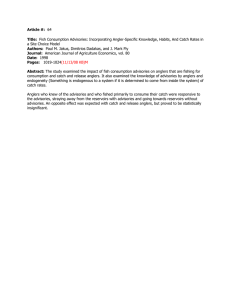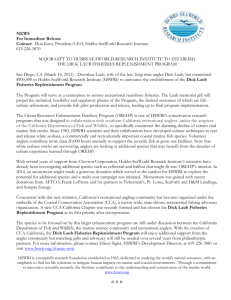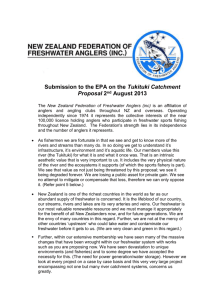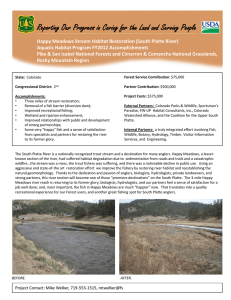THE DYN AMIC S OF R ECR EAT IONA... Zurilea Steenkamp Wilb ard N asha ndi
advertisement
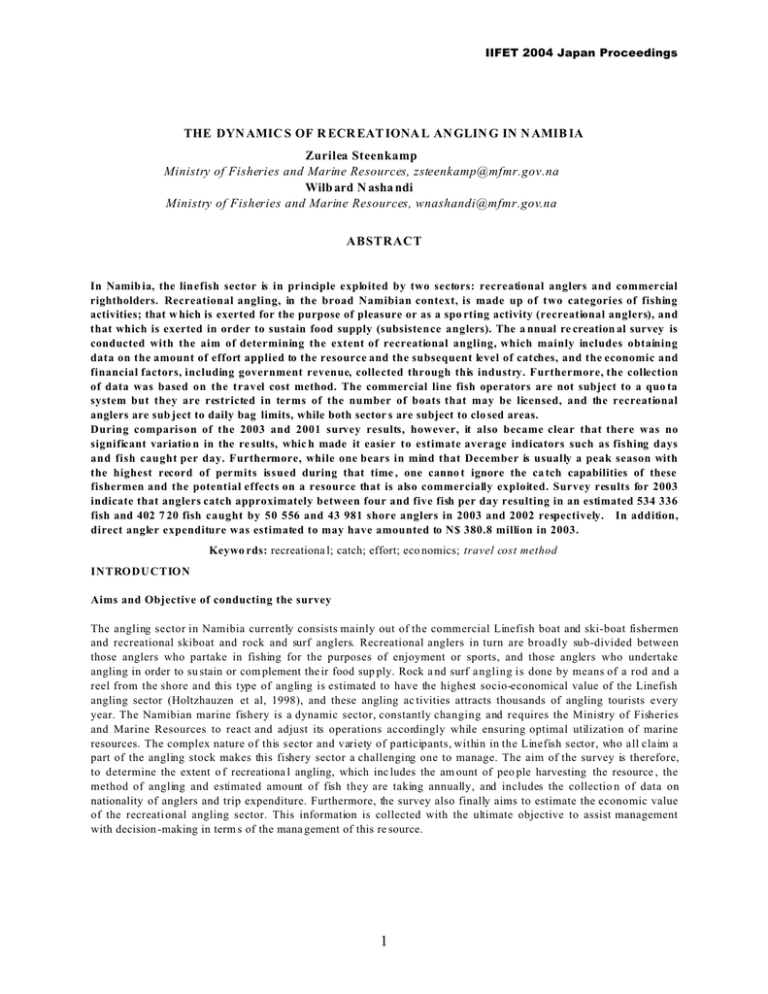
IIFET 2004 Japan Proceedings THE DYN AMIC S OF R ECR EAT IONA L AN GLIN G IN N AMIB IA Zurilea Steenkamp Ministry of Fisheries and Marine Resources, zsteenkamp@mfmr.gov.na Wilb ard N asha ndi Ministry of Fisheries and Marine Resources, wnashandi@mfmr.gov.na ABSTRACT In Namib ia, the lin efish sector is in principle exploited by two sectors: recreational anglers and commercial rightholders. Recreational angling, in the broad Namibian context, is made up of two categories of fishing activities; that w hich is exerted for the purpose of pleasure or as a spo rting activity (recreational anglers), and that which is exerted in order to sustain food supply (subsistence anglers). The a nnual re creation al survey is conducted with the aim of determining the extent of recreational angling, which mainly includes obtaining data on the amount of effort applied to the resource and the subsequent level of catches, and the economic and financial factors, including government revenue, collected through this industry. Furthermore, the collection of data was based on the travel cost method. The commercial line fish operators are not subject to a quo ta system but they are restricted in terms of the number of boats that may be licensed, and the recreational anglers are sub ject to daily bag limits, while both sector s are subject to clo sed areas. During comparison of the 2003 and 2001 survey results, however, it also became clear that there was no significant variatio n in the re sults, whic h made it easier to estimate average indicators such as fishing days and fish caught per day. Furthermore, while one bears in mind that December is usually a peak season with the highest record of permits issued during that time , one canno t ignore the ca tch capabilities of these fishermen and the potential effects on a resource that is also commercially exploited. Survey results for 2003 indicate that anglers catch approximately between four and five fish per day resulting in an estimated 534 336 fish and 402 7 20 fish caught by 50 556 and 43 981 shore anglers in 2003 and 2002 respectively. In addition, direct angler expenditure was estimated to may have amounted to N$ 380.8 million in 2003. Keywo rds: recreationa l; catch; effort; eco nomics; travel cost method INTRODUCTION Aims and Objective of conducting the survey The angling sector in Namibia currently consists mainly out of the commercial Linefish boat and ski-boat fishermen and recreational skiboat and rock and surf anglers. Recreational anglers in turn are broadly sub-divided between those anglers who partake in fishing for the purposes of enjoyment or sports, and those anglers who undertake angling in order to su stain or com plement the ir food sup ply. Rock a nd surf a ngling is done by means of a rod and a reel from the shore and this type of angling is estimated to have the highest socio-economical value of the Linefish angling sector (Holtzhauzen et al, 1998), and these angling ac tivities attracts thousands of angling tourists every year. The Namibian marine fishery is a dynamic sector, constantly changing and requires the Ministry of Fisheries and Marine Resources to react and adjust its operations accordingly while ensuring optimal utilization of marine resources. The complex nature of this sector and variety of participants, within in the Linefish sector, who all claim a part of the angling stock makes this fishery sector a challenging one to manage. The aim of the survey is therefore, to determine the extent o f recreationa l angling, which inc ludes the am ount of peo ple harvesting the resource , the method of angling and estimated amount of fish they are taking annually, and includes the collectio n of data on nationality of anglers and trip expenditure. Furthermore, the survey also finally aims to estimate the economic value of the recreati onal angling sector. This information is collected with the ultimate objective to assist management with decision -making in term s of the mana gement of this re source. 1 IIFET 2004 Japan Proceedings OVERVIEW OF THE LINEFISH INDUSTRY The most popular angling fish species include kob (Argyrosomus inodorus), also known as kabeljou, West Coa st steenbras (Lithogn athus au reti), and snoek (Thyrsites atun) and they form part of the multi-species catch of both the commercial linefish and recreational rock- and surf-angling sectors. The commercial Linefish boats and skiboats are not subject to a q uota fee system and may ca tch as many linefish spe cies per year as they are ab le to, while recreational anglers are su bjected to the daily bag lim its in terms of the reg ulations and they are not allowed to sell their catches. The commercial Linefish sector are however restricted in terms of the number of boats that can be licensed for each season, and the recreational anglers are further subjected to size limits. Catches of commercial Linefish boats and ski-boats are recorded in logbooks on a daily basis, but the catches from recreational skiboats and rock – and surf – anglers have to be estimated through interviews and by me asuring their ca tches (Ho ltzhauzen et a l, 1998). Currently the commercial Linefish sector consists of 12 rightholders, while there are no limitations on the number of recreational anglers per season. There have been a perception that there is an apparent decline in CPUE of Linefish along the Namibian coast, which is the cause of conflict between commercial and recreational anglers who blame each other, with commercial anglers feeling that recreational anglers threaten their livelihood, while recreation al anglers feel that commercial anglers are to blame for the decline in the stock (Kirchner et al, 2000). The target reference level of depletion for both the silver kob and the west coast steenbras stock was set at 50%. The biomass for silver kob is estimated to be about ± 7500 tonnes, while the size of the stock is currently in the region of 40% of its original (before exploitation) state. The spawning (adult) stock biomass of W est Coast steenbras is sm all and estimated to be in the region of 2 000 tonnes. The stoc k size is abou t 53% o f its pristine (before exploitation ) state (MF MR, 2 003). METHODOLOGY The survey was a random sample of recreational anglers, partaking in fishing activities along the Namibian coastal areas betw een Ter race Ba y and M eob B ay. In order to be repres entative and efficient, the samp le size repres ented in the document amounted to 465 anglers allowing for a margin of +/- 4%, and a confidence level of 95%. T wo sets of questionnaires were used during the survey. One questionnaire was aimed at recreational anglers and the second was aimed at subsistence anglers. One of the limitations to the survey was the absence of a clearly defined distinction between subsistence and recreational anglers and every attempt was made to correctly classify the anglers in the category that they belong. It became clear however that the proportion of subsistence anglers interviewed were very small as the majority o f interviewees we re recreatio nal anglers. Su bsistence an glers usually resid e in the coasta l towns, walked to the beach and generally had little money to spend on modern and expensive angling equipment or bait (Kirchner et al, 2000 ) and therefo re the contrib ution from the subsistence se ctor was de termined to be negligible. The first survey of this nature was conducted in 2001, and prior to conducting the 2003 survey, it was deemed necessary to r eview the form at of the survey d ocumen t and some changes wa s made to th e original docum ent. These changes, in essence made it difficult to compare it directly to some of the results obtained and analysed during the 2001 survey but it was possible to comp are certain indicators such as averag e angler days, fish caught per day and expenditure per angler. Furthermore, due to the fact that the issue of permits was only implemented in December 2001, the study had to make use of the data for 2002 and 2003 in o rder to obtain the actual number of anglers for ea ch season and thus our a nalysis focused on these two perio ds. All interviews were carried out under the authority of the M inistry of Fisheries a nd Ma rine Resou rces and all interviewers were emp loyees of the M inistry and carrie d the Min istry’s Identification cards. The major component of these efforts was focused to on – site interviews of ang lers. In addition to the shore anglers who were willing to be interviewed, further sources of data include the Ministry of Fisheries and Marine Resources, while literature references were also made to an overview of the kob fishery by Holtzhauzen et al (1998), and a separate study on the economic evaluation of the recreational angling sector conducted by Kirchner et al (2002). The aim of this paper was also to provide an economic evaluation of the recreational sector, however, we must state that our methods differed from that used by Kirchner et al (2002), since these were two separate surve ys. 2 IIFET 2004 Japan Proceedings RESULTS Profile of Anglers The survey aimed to get an overview of the demographic pro file of anglers by looking at the nationality, gender and age structure of anglers. In add ition, the emp loyment and income statu s of these angle rs will also be illustrate d in order to h ave an und erstanding o f the econom ic status of angler s. The overwhelm ing majority o f recreationa l anglers cons ist of males, which m ade up 8 4% of all re sponde nts, while female angle rs made up 16% of total anglers interviewed. In addition, the majority of anglers, amounting to 41%, fell in the age group between 31 and 50 years in 2003, while anglers who fell in this age group made up 52% o f all respond ents in 2001. In addition, 3 6% of an glers were em ployed, 2 6% of a nglers were self-employed, while 17% and 11% of respondents reported to be students and retired respectively. The majority of anglers interviewed (37%), reported earnings of less than N$ 2000,00 per month, which may be c ontributed to the fact that 17 % of resp ondents reported to be students while 11% of respondents are retired. On the other hand 21% of interviewees reported monthly inco mes in exce ss of N$ 1 1 000,0 0 per mo nth. The majority of anglers consisting of 83% (2003) and 87% (2002), prefer beach angling, while 13% and 11% of the sample anglers interviewed in 20 03 and 2 001 resp ectively, indicate d that they also d o rock an gling. A very sm all percentage of anglers, amounting to 4% and 2% of the respondents in 2003 and 2001 respectively, indicated that they also und ertook ski-b oat fishing. Catch and Effort The effort exerted on the linefish reso urce by the re creational an glers is considerable, given the fact that this is a fishery also exploited by the commercial L inefish industry. The majority of the participants in the 2003 survey (33%) indicated that an angling trip runs fo r approximately 7 days, while 26% of the anglers interviewed indicated that an angling trip consist app roximately o f 14 days. T he main species targeted by the recreational anglers are Silver Kob (Kabeljou) (33% ), West Coast Steenbras (27%) and Galjoen (25 %). As can be seen from Gra ph 1 and 2, the numb er of anglers inc reased by a pproxim ately 15% from 43 9 81 anglers in 2002 to 50 556 anglers in 2003, while the distribution of anglers followed the same trend in both years, indicating peak p e ri od s in M arch and December. N on- Nam ibian anglers in creased b y 30% in 2 003 co mpared to 2002 , while Namibian anglers increased by 9% in 2003 compared to 2002. A survey conducted by the M inistry of Environment and Tourism reve aled that next to Windh oek, the N amibian co ast, specifically Sw akopm und and W alvisbay a re, respectively, the second and third m ost popu lar locations (M ET, 20 02) for tou rists (see Annexure 1 for map of Namibia). In additio n to political stability and good infrastructure, Namibia is also renowned for its beautiful landscapes and tourists are reported to have cited this, in addition to the fact that one th ird have visited Namibia before, as the main reaso ns that they visit Na mibia (M ET, 20 02). Based on the computed results, the majority of anglers, 44% and 47% in 2003 and 2001 respe ctively, reported to be catching on average between four and five fish per day. As a result of the similar results obtained from these two surveys, this estimate was considered as a reliable indicator of angling activity and was thus used to compute the mean num ber of fish cau ght. 3 IIFET 2004 Japan Proceedings The estimated number of angler days increased from 307 867 angler days in 2002 to 353 892 angler days in 2003, as seen in Table 1. The total number of angler days per year was estimated by multiplying the daily mean number of anglers by the mean number of days spent fishing per trip for each season. Table 1: Estimated values of angler days for 2003 and 20 02, (numbers) 2003 Mean number of Anglers per day 138 Standard Deviation 90 Mean number of Anglers per month Standard Deviation Estimated total number of Angler Days per annum 4213 2798 353892 2002 120 96 3665 3000 307867 Based on the estimated mean number of anglers per day and a mean catch of between four and five fish per day, an estimated number of 534 336 fish could have been caught by recreational anglers in 2003, compared to an estimated number of 402 720 fish in 2002. The est imated number of fish caught, is computed by multiplying the mean number of anglers per day by the mean number of fish caught per day. The Ministry of Fisheries and Ma rine Resources, however, estimated that the total catch for the recreational fishery amounted to approximately 245 tonnes in 2002. Expenditure on Angling/ Willingness to Pay One way of determining the economic value of the recreational Linefish fishery is to determine the value in use (this is the total amount that the angler is willing to pay for the activity. It consists not only of the anglers’ actual expenditure but also the ‘consumer surplus’ which is the difference between what the angler is willing to pay and what is actually paid) (Kirchner et al, 2000 ). All monetary values was estimated in Namibian Dollars (N$) and the exchange rate prevalent at the time of the survey, December 2003 was as follows: N$1,00 =ZAR 1,00=US$ 0.1532. Results from the survey indicated, as expected, a higher total average cost for South Africans com pared to Namibians as can been seen from Table 2. Based on our estimations of the average cost per angler and the number of anglers (50 556) that engaged in recreational fishing during the 2003 fishing season, the total expen diture that could have been incurred by anglers is estimated to have amounted to approximately N$ 452.6 million. Direct expenditure that may have b een incurred by shore an glers within the N amibian b orders is estim ated to have amounte d to approx imately N$ 380.8 m illion in 2003 . Table 2: Expenditure by Recreational Anglers per angler, 2003 (Standard Deviation) Namibians South Africans Mean Travel Cost 1 980 2 924 Mean Accommodation Cost 2 300 3 014 Mean Entertainment Cost 1 450 2 284 Mean Cost of Fishin g* 2 184 4 375 Total Cost of an angling trip 7 914 12 597 Average Cost per fish 256 Value per Angler Aggregate Value 7 768 N$ 380.8 million 2 253 N$ 110.4 million 10 021 N$ 491.3 million Direct angler expenditure1 2 Consumer surplus 3 Value in use/Willingness to pay * The c osts asso ciated w ith fishing equipm ent and bait. 1 2 3 Direct expenditure within Namibia. Indirect estimation – Direct Expenditure * 0.29 (Kirchner et al, 2000) Sum of consu mer surplus and d irect expenditure 4 IIFET 2004 Japan Proceedings The aggregate c onsumer su rplus for the re creational an gling sector in 2 003 is estimated to have am ounted to approx imately N$ 11 0.4 million, as in dicated in Table 2. The estimated consumer surplus excludes some elements of expenditure by non-Namibians, such as travel cost, as it is difficult to differentiate be tween what w as spent within the borders of Namibia and that spent outside of it, and also some cost elements in the cost of fishing such as rods, tackles and reels was also excluded , as it is assumed tha t these expen ditures have been incurr ed before the trip was undertaken. The consumer surplus refers to an economic benefit that accrues o nly to Nam ibians (Kirc hner et al, 2000). The consumer surplus was not estimated directly by this study but was calculated by using the indicator applied in the study by Kirchner et al (2000) where they assumed that the consumer surplus of anglers was 29% of their expenditures. An estimated number of 534 336 of fish was harvested in 2003 and based on estimated expenditure in 2003, the average cost per fish, amounted to N$ 256. Based on a survey conducted by Kirchner et al (2000) in 1996/7, it was estimated that 8 800 shore anglers spent a total of N $ 29.7 million in 1996/7 while the cost per fish amounted to N$ 95. Government Revenue Recreational anglers are required to purchase a permit in order to take part in angling, and these permits are either monthly , at a fee of N$14, or annual, at a fee of N$168. The commercial Linefish operators in turn are required to pay a vessel license fee, as well as a fund levy of N$25 per ton of fish caught. As can be seen from Graph 3 below, government revenue from the recreational angling sector is significantly higher, and amou nted to N $ 900 4 38 in 2003, than that collected from the commercial Linefish operators indicated in Graph 4, which amounted to an estimated N$42 796 in 200 3. As can clearly be seen, the opportunity cost attached to the recreational angling sector is significantly higher than for the commercial sector in terms of the revenue that would be foregone if the recreationa l angling sector should be closed. 5 IIFET 2004 Japan Proceedings Furthermore, following a co mparison between the governm ent revenue collected fro m the commercial Linefish operators and the value of the catch, it is clear that the government reven ue collected by this sector makes u p less than 1% of the final value of the catch, which amounted to an estimated N$13.3 million in 2003. 5. CONCLUSIONS The number of recreational anglers has increased considerably from approxima tely 8 800 in 1996/7 (Kirchner et al, 2000) to 50 55 6 in 2003 . It is clear that this increase in the number of recreational anglers has resulted in increased pressure on the Linefish stocks, which is simultaneously exploited by the commercial Linefish operators. As can be seen, the contribution of the recreatio nal anglers to the econom y may have am ounted to a n estimated N $ 380.8 million in 2003, compared to an estimated N$ 1 3.3 million contribution to the eco nomy by the comm ercial Linefish operators in 2003. The recreational angling sector contributes significantly to the Namibian economy, not only in terms of direct expenditure but also indirectly in terms of spin-offs to various sub-sectors and it can further be argued that the recreational angling contributes significantly to sustaining employment, especially coastal economies that are highly dependent on tourism. It may be argued that the recreational ang ling sector co ntributes mo re significantly to the Namibian economy overall, and sho uld therefore enjoy prefe rence ove r the comm ercial linefish indu stry with regard to access to th e resource . Howev er, it must also be acknowle dged that the comme rcial Linefish operators have made investments in the fishery of approximately N$ 6.2 million in Linefish boats, fishing gear and processing facilities, while also contributing direc tly to employm ent creation. T he comm ercial linefish secto r is estimated to have emp loyed app roximately 2 36 peo ple in 200 3 of which 8 0% wer e Namib ian. Both sectors con tribute significantly to th e exploitatio n of the resource, it is however worth noting that the current management and conservation measures such as the bag limits , size limits, restrictions on the number of commercial boats and closed areas have played a m ajor role in su staining a resou rce that have s imultaneou sly been exp loited by two principal sectors. In addition, the Ministry of Fisheries and Marine Resources has recently terminated the commercial linefish rights of 9 rightholders who did not meet the criteria for the extension of a right and it is not likely that these rights will be renew ed or rep laced in the fo reseeable future. Alternative options are continuous ly explored in order to improve the sustainable management of this resource. While it appears that more measures could be introduced to aid the conservation o f the Linefish stock , the econo mic and social importance of both sectors should also be taken into consideration. The termination of commercia l harvesting rights may n ot be an option due to the investments made and employment created by the commercial Linefish sector, while closing the Linefish fishery to re creational an glers would have significant e conom ic implications to especially the coastal communities. It is clear however that a decision in favor of the commercial rightholders would resu lt in considera ble loss of rev enue to the go vernment w hile the opp ortunity cost of d eciding in favor of the recreational anglers would be negligible in terms of the revenue foregone by the commercial sector. REFERENCES Holtzhau zen, J. A., and Kirchner, C . H. 199 8 – Ko b Fishery in N amibia. Namibia Brief 20: 130-133. Kirchner, C. J., Sakko, A. L. and Barnes, J. I. 2000 - An Economic Valuation of the Namibian Recreational ShoreAngling Fishe ry. South African. Journal of Marine Science. 22: 17-25. Ministry of F isheries and M arine Reso urces. 200 3 – Annu al Repor t of 2002 . Ministry of E nvironme nt and To urism. 200 2 – Nam ibia Visitor E xit Survey 20 02. 6 IIFET 2004 Japan Proceedings Annex 1: Ma p of Nam ibia and neighboring coun tries Source: M inistry of Fisheries an d Ma rine Resour ces 7
